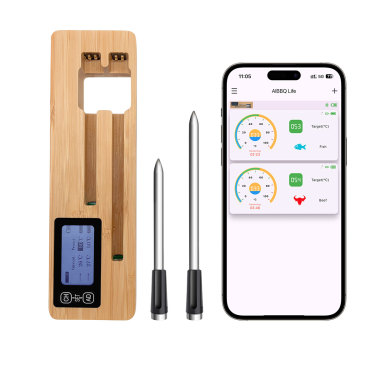
# Digital Meat Thermometer: The Essential Tool for Perfect Cooking
## Why Every Kitchen Needs a Digital Meat Thermometer
Cooking meat to perfection is both an art and a science. While experience and intuition play important roles, nothing beats the precision of a digital meat thermometer when it comes to ensuring food safety and achieving ideal doneness. This simple yet powerful tool has revolutionized home cooking by taking the guesswork out of preparing meats.
Unlike traditional analog thermometers, digital versions provide instant, accurate readings that help prevent both undercooking (which can be dangerous) and overcooking (which ruins texture and flavor). Whether you’re grilling steaks, roasting a turkey, or smoking brisket, a digital meat thermometer is your best ally in the kitchen.
## Key Features to Look For
1. Fast and Accurate Readings
The best digital meat thermometers provide temperature readings within 2-3 seconds with an accuracy of ±1°F. Look for models with high-quality probes and advanced sensors for reliable performance.
2. Temperature Range
Keyword: digital meat thermometer
A good thermometer should cover a wide range from at least 32°F to 392°F (0°C to 200°C) to handle everything from rare steaks to deep-frying.
3. Waterproof Design
Since cooking can get messy, choose a waterproof model that’s easy to clean and can withstand occasional splashes or quick rinses.
4. Backlit Display
For outdoor cooking or dimly lit kitchens, a backlit screen ensures you can read temperatures easily in any lighting condition.
## How to Use Your Digital Meat Thermometer Effectively
Proper Probe Placement
Insert the probe into the thickest part of the meat, avoiding bones and fat. For poultry, check both the breast and thigh areas. For large roasts, take multiple readings in different spots.
Understanding Safe Temperatures
Memorize these key internal temperature guidelines:
- Beef, lamb, veal (medium-rare): 130-135°F
- Pork: 145°F
- Poultry: 165°F
- Fish: 145°F
Resting Time Matters
Remember that meat continues to cook after removal from heat (carryover cooking). Remove your meat from heat when it’s 5-10°F below the target temperature, then let it rest before serving.
## Advanced Techniques with Your Thermometer
Beyond basic temperature checking, your digital meat thermometer can help with:
1. Testing Oil Temperature
Perfect for frying, check that your oil has reached the ideal temperature (usually 350-375°F) before adding food.
2. Proofing Bread Dough
Insert the probe into your dough to check if it’s reached the ideal proofing temperature of about 78-82°F.
3. Candy Making
Many digital thermometers can help you monitor sugar syrup temperatures for perfect caramel, fudge, or other confections.
## Maintenance and Care Tips
To keep your digital meat thermometer functioning optimally:
- Clean the probe thoroughly after each use with warm, soapy water
- Avoid submerging the display unit unless it’s specifically waterproof
- Store in a protective case to prevent damage to the probe
- Replace batteries promptly when they run low to maintain accuracy
